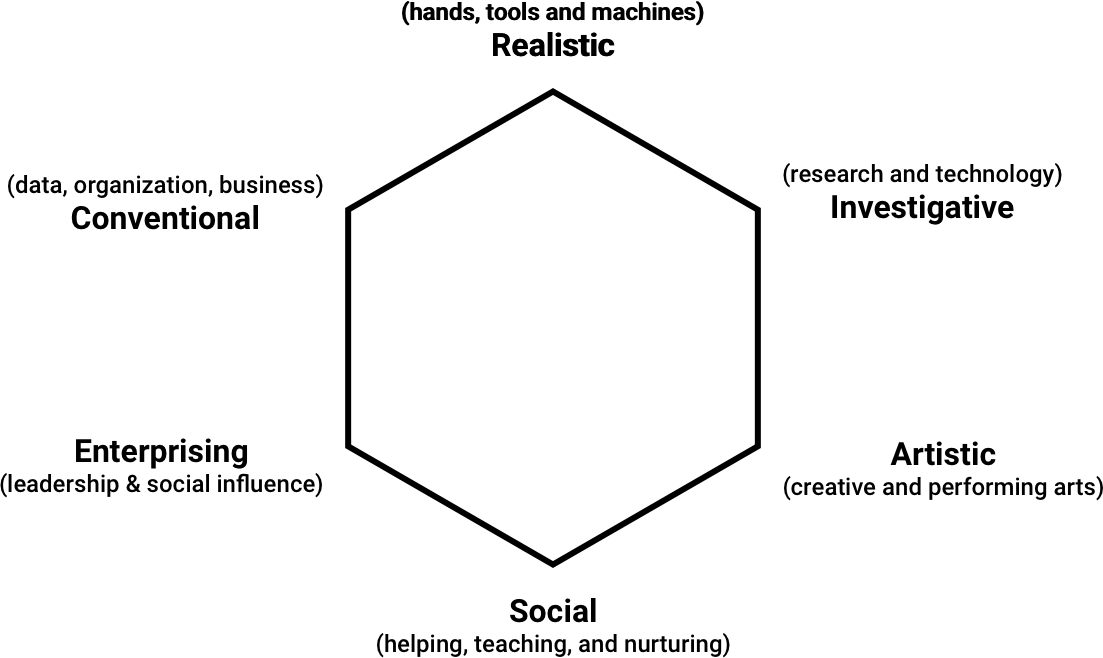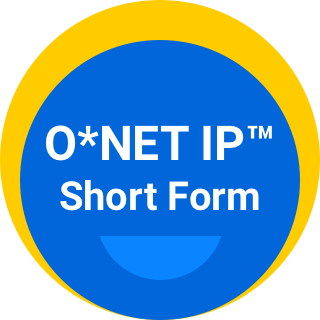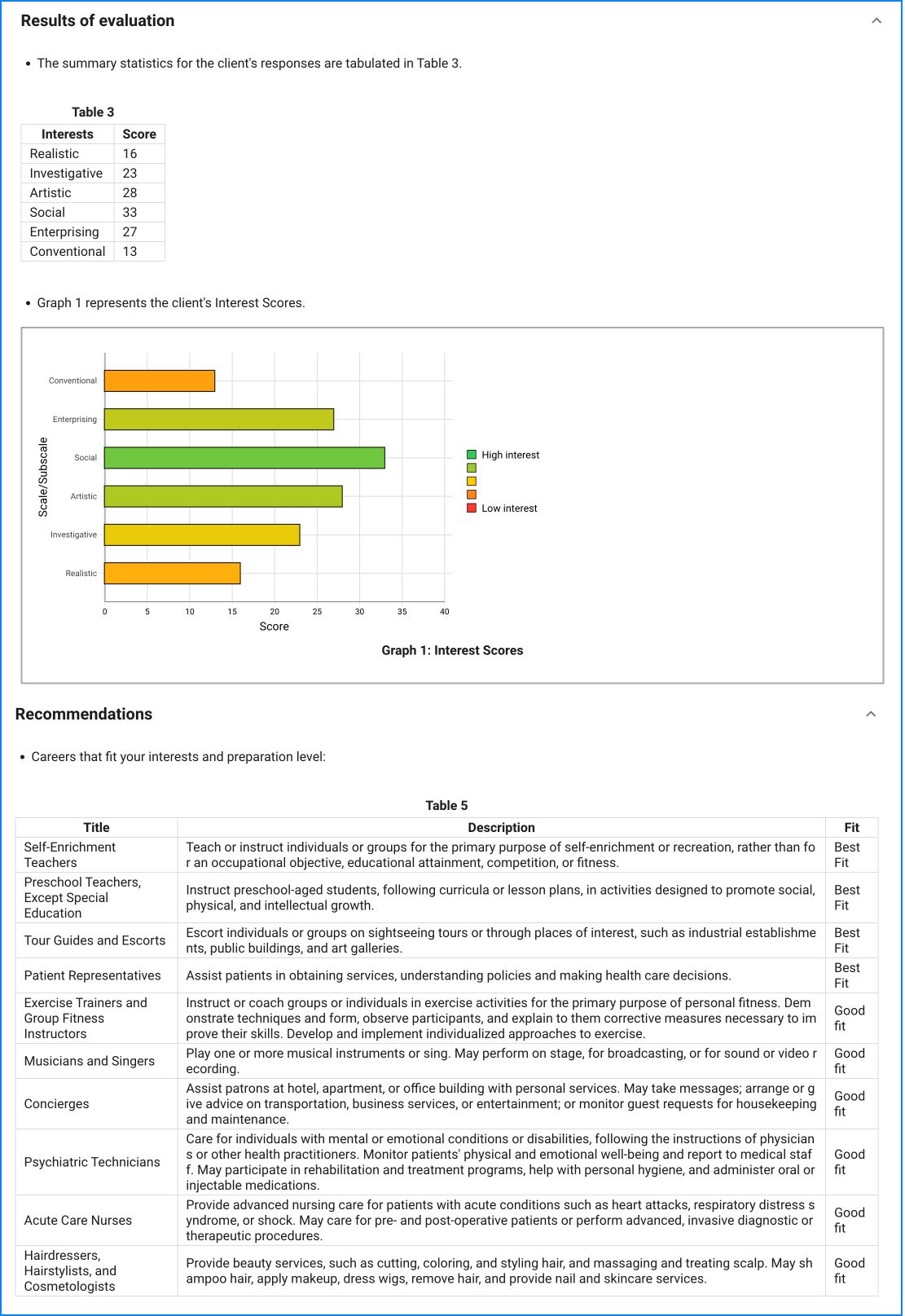Vocational interests are trait-like preferences for activities, environments, or outcomes that motivate goal-oriented behavior (Rounds & Su, 2014). More simply, interests describe what people like to do and where they like to focus their attention and effort. Vocational interests are a unique psychological variable in that they are directly contextualized to work and educational environments. By asking what people like to do, interest assessments capture the degree of fit between a person’s interests and the characteristics of different environments. This concept—person-environment fit—explains why interests are a powerful predictor of the choices people make throughout their careers and whether they are successful (Su, Stoll, & Rounds, 2018).
The O*NET Interest Profiler (IP) uses Holland’s (1959, 1997) RIASEC model to measure and classify vocational interests. Holland’s model is the most widely used theoretical framework for measuring interests. Holland’s typology describes people and work environments based on six vocational personalities and environments, together known as RIASEC: realistic (R), investigative (I), artistic (A), social (S), enterprising (E), and conventional (C). These types are organized in a hexagon, also described as a circular structure (Day & Rounds, 1998), outlined in Figure 1. The interest categories that are next to each other (adjacent) on the hexagon are more closely related than those further away or opposite on the hexagon. For example, Realistic interests that involve working with hands, tools, and machines are closely related to Investigative interests associated with science and technology.

Figure 1. Holland’s RIASEC Vocational Interest Model.
- Realistic: Realistic careers involve working with hands, tools, and machines. Realistic activities often deal with plants, animals, and real-world materials like wood, tools, and machinery. Many of the careers involve practical problems and solutions, and occasionally working outdoors.
Example basic interests: mechanics, engineering, outdoors, construction, agriculture
Example careers: farmworkers, civil engineers, and carpenters
- Investigative: Investigative careers involve working with ideas, and scientific and research pursuits. Investigative activities often require an extensive amount of thinking. These careers can involve searching for facts and figuring out problems mentally.
Example basic interests: medical science, life science, physical science, mathematics
Example careers: biologists, veterinarians, and chemists
- Artistic: Artistic careers involve self-expression and creativity and are typically associated with the performing, written, and visual arts. Artistic activities often require working with forms, designs and patterns, and the work can be done without following a clear set of rules.
Example basic interests: media, design, performing arts, music, writing, culinary art
Example careers: actors, writers, art directors
- Social: Social careers involve helping, nurturing, and teaching other people. These careers often require assisting or providing service to others.
Example basic interests: social science, education, health care service, humanities Example careers: counselors, teachers, child and family social workers
- Enterprising: Enterprising careers involve selling, managing, and social influence typically in a business context. Enterprising activities often require supervising people, leading projects, and making decisions.
Example basic interests: management, marketing, public speaking, sales, politics Example careers: managers, salespersons, and restaurant bar and waiting staff
- Conventional: Conventional careers involve the ordered and systematic manipulation of data with clear standards, typically, in a business setting. Conventional activities typically require following set rules with an attention to detail.
Example basic interests: finance, accounting, information technology, office work
Example careers: accountants, bank tellers, inspectors
A key assumption of Holland’s RIASEC model is that interest inventories do not simply measure interests. They provide information about interrelated preferences, traits, self-concepts, values, and abilities. Holland originally described the RIASEC categories as ‘personality types’ to denote the surplus meaning associated with RIASEC vocational interests. This is consistent with Holland’s (1958) initial proposal that “the choice of an occupation is an expressive act which reflects the person’s motivation, knowledge, personality, and ability” (p. 336). Thus, although the O*NET Interest Profiler assesses vocational interests, it also provides information about a range of other variables that develop in relation to interests (e.g., personality traits, abilities, and values).
The O*NET-SOC is based on the Standard Occupational Classification [(SOC); Office of Management and Budget, 2000] system. In some cases, the O*NET-SOC describes occupations at a more detailed level than does the SOC to reflect needed occupational specificity. The O*NET-SOC 2010 taxonomy includes 1,110 occupational titles, 974 of which represent O*NET data-level occupations. (National Center for O*NET Development, 2010). Data-level occupations are those occupations for which the O*NET program collects data. Data and occupational information are collected on a wide variety of variables and scales, such as occupational characteristics and worker requirements drawn from the O*NET Content Model. Data are gathered from job incumbents and occupation experts for domains such as knowledges, work activities, work context, tasks, and educational requirements. Additionally, trained occupational analysts, following standardized procedures, independently conduct an analysis of occupational information provided by job incumbents to develop occupational ability and skills information.

Figure 2. The O*NET® Content Model
For career exploration purposes, O*NET-SOC occupations are categorized into five Job Zones on the basis of the amount of education, training, and/or experience each occupation requires. Job Zones are ordered according to increasing levels of education, training, and/or experience, such that Job Zone 1 contains occupations requiring the least preparation, and Job Zone 5 contains those occupations requiring the most preparation (National Center for O*NET Development, 2008; Oswald, Campbell, McCloy, Rivkin, & Lewis, 1999).
Each O*NET-SOC occupation has an occupational score profile that enables direct linkage of the occupation with score profiles generated from the O*NET Interest Profiler. For the Short Form, each occupation has a specific interest score profile that corresponds to interest information measured by the Interest Profiler assessment.





